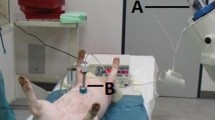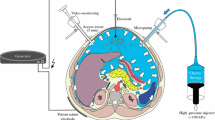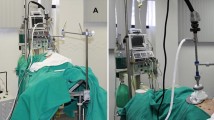Abstract
Background
Pressurized intraperitoneal aerosol chemotherapy (PIPAC) is a novel approach to delivering intraperitoneal chemotherapy (IPC) as a pressurized aerosol. One of the assumed advantages is the homogeneous drug distribution in the intraperitoneal cavity compared with conventional liquid in situ chemotherapy. However, to date, the spatial drug distribution pattern of PIPAC has not been investigated in detail.
Methods
Doxorubicin was aerosolized in an ex vivo PIPAC model containing native fresh tissue samples of swine peritoneum at a pressure of 12 mmHg CO2 at 36 °C. In the center of the top cover of the PIPAC chamber, a PIPAC micropump was installed. Tissue specimens were placed as follows: (A) bottom of the plastic box, (B) margin of the aerosol jet covered with a bilaterally open tunnel, (C) side wall, and (D) top cover, respectively. In-tissue doxorubicin penetration was measured using fluorescence microscopy on frozen thin sections.
Results
The depth of doxorubicin penetration was found to be significantly higher in tissues directly exposed to the aerosol jet (A: 215 ± 79 µm) compared with the side wall (C: 77 ± 18 µm; p < 0.01) and the top of the box (D: 65 ± 17 µm; p < 0.01). The poorest penetration was observed for peritoneal tissue covered under a bilaterally open plastic tunnel (B: 34 ± 19 µm; p < 0.001).
Conclusions
The study data suggest that the spatial drug distribution pattern of ex vivo PIPAC is heterogeneous.



Similar content being viewed by others
References
Sadeghi M, Arvieux C, Glehen O, et al. Peritoneal carcinomatosis from non-gynecologic malignancies: results of the EVOCAPE 1 multicentric prospective study. Cancer. 2000;88:358–63.
Sugarbaker PH. Peritoneal carcinomatosis: is cure an option? J Clin Oncol. 2003;21:762–4.
Verwaal VJ, van Ruth S, de Bree E, et al. Randomized trial of cytoreduction and hyperthermic intraperitoneal chemotherapy with peritoneal carcinomatosis of colorectal cancer. J Clin Oncol. 2003;21:3737–42.
Glehen O, Kwiatkowski F, Sugarbaker PH, et al. Cytoreductive surgery combined with perioperative intraperitoneal chemotherapy for the management of peritoneal carcinomatosis from colorectal cancer: a multi-institutional study. J Clin Oncol. 2004;22:3284–92.
Elias D, Gilly F, Boutitie F, et al. Peritoneal colorectal carcinomatosis treated with surgery and perioperative intraperitoneal hyperthermic chemotherapy: retrospective analysis of 523 patients from a multicentric French study. J Clin Oncol. 2010;28:63–8.
Verwaal VJ, bruin S, Boot H, et al. 8-Year follow-up of randomized trial: cytoreduction and hyperthermic intraperitoneal chemotherapy versus systemic chemotherapy in patients with peritoneal carcinomatosis of colorectal cancer. Ann Surg Oncol. 2008;15:2426–32.
Dedrick RL, Myers CE, Bungay PM, et al. Pharmacokinetic rational for the peritoneal drug administration in the treatment of ovarian cancer. Cancer Treat Rep. 1978;6:1–11.
Los G, Mutsaers PH, van der Vijgh WJ, et al. Direct diffusion of cis-diamminedichloroplatinum(II) in intraperitoneal rat tumor after intraperitoneal chemotherapy: a comparison with systemic chemotherapy. Cancer Res. 1989;49:3380–4.
Jacquet P, Sugarbaker PH. Peritoneal-plasma barrier. Cancer Treat Res. 1996;82:53–63.
Jain RK. Barriers to drug delivery in solid tumors. Sci Am. 1994;271:58–65.
Flessner MF. The transport barrier in intraperitoneal therapy (review). Am J Physiol Renal Physiol. 2005;288:433–42.
Solaß W, Hetzel A, Nadiradze G, et al. Description of a novel approach for intraperitoneal drug delivery and the related device. Surg Endosc. 2012;26:1849–55.
Solaß W; Kerb R, Mürdter T, et al. Intraperitoneal chemotherapy of peritoneal carcinomatosis using pressurized aerosol as an alternative to liquid solution: first evidence for efficacy. Ann Surg Oncol. 2014;21:553–9.
Jacquet P, Stuart OA, Chang D, et al. Effects of intraabdominal pressure on pharmacokinetics and tissue distribution of doxorubicin after intraperitoneal administration. Anticancer Drugs. 1996;7:596–603.
Hinds WC. Aerosol technology. 2nd ed. Hoboken: Wiley-Interscience; 1999.
Solaß W, Herbette A, Schwarz T, et al. Therapeutic approach of human peritoneal carcinomatosis with Dbait in combination with capnoperitoneum: proof of concept. Surg Endosc. 2012;26:847–52.
Rubin BK. Air and soul: the science and application of aerosol therapy. Respir Care. 2010;55:911–21.
Reymond MA, Solaß W. Pressurized intraperitoneal aerosol chemotherapy—cancer under pressure. 1st ed. Berlin: De Gruyter; 2014.
Author Contribution
Khosrawipour Veria: Study design, laboratory analysis, data acquisition and drafting of the manuscript. Khosrawipour Tanja: Laboratory analysis, data acquisition and manuscript drafting. Diaz-Carballo David: Supervision of the experiments, statistical analysis, data interpretation and manuscript drafting. Förster Eckart: Labor analysis, data acquisition and drafting of the manuscript. Zieren Jürgen: Supervision of the study, drafting and critical revision for important intellectual content of the manuscript. Giger-Pabst Urs: Study design, supervision of the study, data interpretation, drafting and critical revision for important intellectual content of the manuscript.
Disclosure
This study was financed by institutional funds. There are no conflict of interest or financial ties to disclose.
Author information
Authors and Affiliations
Corresponding author
Additional information
Khosrawipour Veria and Khosrawipour Tanja have equally contributed to this study, and both authors should be considered first author.
Electronic supplementary material
Below is the link to the electronic supplementary material.
Rights and permissions
About this article
Cite this article
Khosrawipour, V., Khosrawipour, T., Diaz-Carballo, D. et al. Exploring the Spatial Drug Distribution Pattern of Pressurized Intraperitoneal Aerosol Chemotherapy (PIPAC). Ann Surg Oncol 23, 1220–1224 (2016). https://doi.org/10.1245/s10434-015-4954-9
Received:
Published:
Issue Date:
DOI: https://doi.org/10.1245/s10434-015-4954-9




